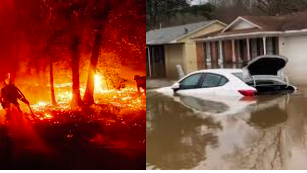Wildfires in the North American west, increased frequency of hurricanes in the American south and flooding in the midwest, all have one thing in common: heat transfer. For the remaining climate change deniers, there is only one real question left: will this new normal last decades, or much, much longer?
As a geology student at Stanford in the 1970’s, I sat with climate scientists who predicated that global warming, which was well-documented way back then, would lead to a number of inevitable changes. Among them, and most locally pressing, would be:
- Increased drought across the American west and southwest, leading to stressed forests, drier timber, and ruined ranch lands.
- More summer lightening storms across the western states.
- More and stronger hurricanes and tornados in the south and along the American Gulf and southern Atlantic coasts.
- More and worse spring flooding in the midwest.
All of these are driven by the inevitable flow of heat from the tropics to the poles. Where that warm air can pick up moisture from the ocean, it generates hurricanes and heavy rain. Where the air is dry, it leads to drought. Drought stresses vegetation from scrub to forests, making them more susceptible to pests and fire storms.
All of this, and much more was accurately predicted decades ago. The ONLY piece the scientists got wrong was the time frame: back in the 1970’s the models suggested we had 100 years to reverse human-generated climate change. We were off by half. These are undeniable facts.
From a human-social point of view, which often creates the basis for political arguments on the left, the kinds of disruptions we are seeing due to massive fires, unbreathable air, and destructive storms is heartbreaking. From an economic point of view, which often creates the basis for political arguments on the right, the cost of re-building after major fires, storms and floods has already become unsustainable.
We have passed a tipping point across both red and blue states in America. The last few years have been the first few years of the new normal for at least decades to come. Yes, there will be years with more and fewer disasters, but overall, this is what we can expect. Where does the money come from to repair and rebuild? Can we keep printing dollars forever? A few of these disasters in one year costs tens of billions of dollars. (On top of one pandemic that costs a few trillion dollars.) Does that sound sustainable to you?
The new normal will last as long as humans prioritize their own narrow interests and conflate uninformed imagination or baseless hope with real science. Is there a chance I am wrong? Sure. But if there is even a 50% chance I am right (and the vast majority of objective scientists, who have cumulatively spent millions of people-years observing, modeling, checking and arguing about it, put that number at 99%), then what is the risk of merely hoping for the best as opposed to prudently working to reverse this mess?
Education is about doing our best to ensure that the next generation benefits from the lessons of the past in order to prepare for the future. Mitigating the impacts of climate change should be the least politically-charged, most collaborative goal of all educators. If not, the firestorms and floods of today are just a small window on what we are leaving for our kids and their kids. We either work to change the future or












Leave A Comment